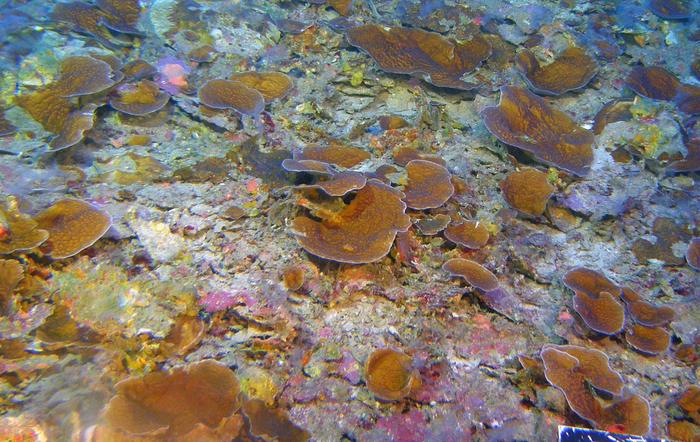In the waters off the Hawaiian Islands, rates of calcification were measured in the deepest coral colonies and reported recently in a study led by a University of Hawai‘i (UH) at Mānoa oceanographer.

Credit: University of Hawai’i–SOEST HURL
In the waters off the Hawaiian Islands, rates of calcification were measured in the deepest coral colonies and reported recently in a study led by a University of Hawai‘i (UH) at Mānoa oceanographer.
Reef building corals require light for photosynthesis to build the reef structure through calcification, but available light declines quickly with increasing water depth. Below about 200 feet, calcification rates for light-dependent corals had previously not been measured.
In the new study published in Coral Reefs, Samuel Kahng, lead author and graduate affiliate faculty of oceanography in the UH Mānoa School of Ocean and Earth Science and Technology (SOEST), reported the first calcification rates from corals (Leptoseris spp.) in Hawai‘i at depths of 230-360 feet.
“In addition to being from the deepest coral analyzed, these are by far the lowest calcification rates ever measured for healthy, light-dependent corals in their natural habitat,” said Kahng. “These rates are 20-40 times slower than observed in shallow water corals.”
Leptoseris spp. dominate the coral community in deep, low-light zones throughout the Indo-Pacific region. This species of coral exhibits a strategic approach to expanding the surface area with which it captures downwelling light–they form very thin horizontal plate-like skeletons to maximize the area that can be built by their very low calcification rates. Kahng and colleagues published a previous study revealing that the lateral growth rates of these plate-like skeletons are unexpectedly high, given the low light availability.
“The corals’ ability to quickly grow horizontal surface area is impressive, especially given the low calcification rates,” said Kahng. “What this points to is the incredibly efficient use of calcification.”
Because Hawai‘i has such clear water, coral reef ecosystems extend offshore to extreme depths, with specialized light-dependent coral communities as deep as 500 feet.
“Hawai‘i has much more vertical habitat compared to other coral reef ecosystems around the world,” said Kahng. “These deep ‘mesophotic’ coral ecosystems can cover more habitat area than shallow water coral reefs. However, the general public rarely see them, so they present unique ecosystem management and conservation challenges.”
In future studies, Kahng and colleagues will continue to try to unlock the secrets that enable these deep corals to thrive using the limited light in one of the ocean’s least studied habitats.
Journal
Coral Reefs
DOI
10.1007/s00338-023-02410-7
Method of Research
Observational study
Subject of Research
Animals
Article Title
Calcification rates in the lower photic zone and their ecological implications
Article Publication Date
12-Aug-2023
COI Statement
There is no conflict of interest.




